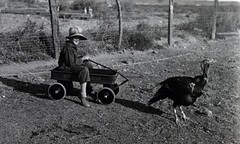During these chilly fall days, we find ourselves daydreaming of warm, exotic lands that serve tantalizing, tempting, and tasty dishes. Thankfully, we have access to both the wonderful world of educational lantern slides from warm locales and pamphlets full of recipes that humor our hunger for hot and historically interesting recipes.
All these “Foreign Recipes” were pulled together by Lambda Chapter of Omicron Nu, National Honorary in Home Economics, for their December 1928 publication (see above).
A Simple Indian Curry (Ceylon)
- One Pound of beef, mutton, fish, or vegetables, as desired.
- One T curry powder
- 1 heaping T butter
- 1 onion
- ½ fresh coconut
- Juice of half a lemon
- Salt to taste.
- Curry powder to be mixed in 2 ounces of water.
- Onion to be finely chopped.
- Coconut to be scraped and soaked in a teacup of boiling water, then squeezed, and the milk ( or liquid) to be put into the curry.
- First cook the butter till it bubbles, put in the onion and let it brown, add the curry powder and let that cook a few minutes; if it becomes too dry and sticks to the pan add a little hot water. Then put it in the meat (raw) cut in small pieces, fish, or vegetables, and fry, then add salt, and if dry, add a little more water.
- When about half done, add the coconut milk and the lemon juice.Let all simmer until meat is thoroughly cooked.
- If not convenient to use the coconut milk, ordinary milk may be used and the mixture thickened with a little flour. Coconut milk thickens without flour.
- When the butter separates and shows itself in the gravy, the curry is ready for serving.
- Curry should be served with plain boiled rice. Pass rice first, then chutney.
- Indian chutney served with curry is a decided improvement.
- A banana cut into pieces about ½ thick and added to the curry mixture while cooking gives a pleasant addition to the flavor.
Repollo Huevos ( Philippino)
- 1 medium-sized cabbage
- 6 eggs
- 2 T lard
- 6 medium sized onions
- 2 ½ t salt
- ½ t pepper
- Remove the outside leaves of the cabbage. Quarter the head, remove the stalk, wash thoroughly. Put into boiling water and cook until tender. Drain and chop the cooked cabbage.
- Slice the tomatoes and onions.
- Heat the lard in the frying pan, add tomatoes and onions.
- When onions are tender, add cabbage and a little hot water to keep mixture moist. Cook ten minutes stirring constantly.
- Add salt, pepper, and beaten eggs.
- Mix thoroughly and serve.
Savory Sippits (English)
- 4 mutton kidneys and a pice of suet the size of two of them
- 3 T bread crumbs
- 4 sprigs of parsley
- 2 shallots
- 1 lemon
- 8 rounds of toast
- 2 T butter
- Yolks of 2 eggs
- Salt and pepper
- Boil the kidney 15 minutes in salted water.
- Cut eight rounds of bread the size of teacups and toast them quickly so they will be soft, not crisp.
- Mince two shallots (or a quarter of an onion); chop to bits a few sprigs of parsley; and grate 1 t of lemon peel.
- Chop kidneys fine, removing the white cartilage, and shred the suet to equal fineness.
- Add to them ¼ t of salt and a dash of pepper.
- Knead the kidneys with the minced greens, 3 T of bread-crumbs, and the yolks of two eggs to make a velvety paste. Should it be too stiff, add a little cream.
- Spread the paste thickly upon the circles of toast.
- Fry them in melted butter or bacon drippings first upon the toast side, then turn them deftly over to brown a bit in top. Dish them up garnished with parsley and lemon, and with melted butter in the dish.
Berlinenkranse (Norwegian)
- 2 hard-boiled egg yolks
- ½ c sugar
- 1 c butter
- 2 raw egg yolks
- 4 c flour
- Mix hard-boiled egg yolks with sugar.
- Then add butter and raw yolks. Add flour.
- Take small pieces of dough and mould into rings.
- Dip in beaten white of egg and sprinkle with coarse white sugar.
- Bake in a moderate oven until light brown.
Soup (Korean)
- ½ pound pork (diced)
- ½ pound veal (diced)
- 4 medium potatoes (diced)
- 1 pound spinach
- ½ head celery
- 6 c water
- ½ c soy bean sauce
- Salt to taste
- Fry the meat in a large kettle. When nearly done add the soy-bean sauce. Allow this to heat.
- Add the water boiling hot, add the cabbage and celery and let cook 10 minutes.
- Add the potatoes and when nearly done add the spinach and let simmer.








